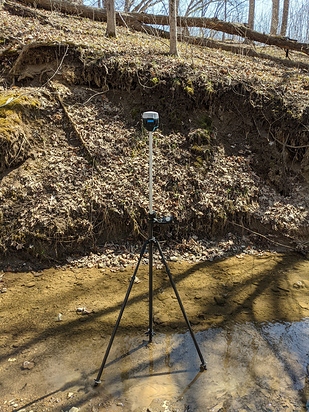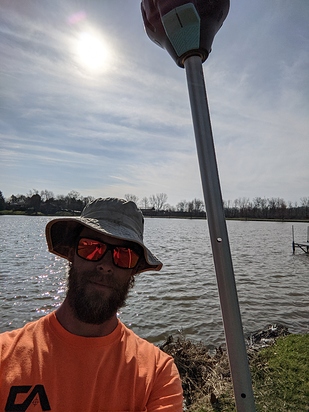Reach RS2 is a handy companion for land surveyors around the world, as it can be easily implemented into existing workflows. Reach RS2 works smoothly with various field software including MicroSurvey’s FieldGenius for Android. Check out how Jon Campbell from Ohio applied Reach RS2 and FieldGenius for Android in his daily business.
Background
Jon Campbell’s family has worked in the survey industry for almost 50 years. His grandfather started the business in 1979. Today, Campbell & Associates is a full-service land surveying firm with over 50 employees. The company’s main focus is on mortgage location surveys.
Jon has been working in the field full-time since 2003 and has experienced tremendous advances in technology. The most significant change, he said, was widespread RTK GNSS systems that ensure accuracy and ease of use.
Mortgage survey with Reach RS2 in Ohio, USA
Jon Campbell surveying with Reach RS2
Reach RS2 for Mortgage Surveys
A title insurance company usually requests a mortgage location survey to confirm the legal description of the property. It requires an on-site field survey of the property boundaries. To enhance productivity, Campbell and Associates use RTK GNSS receivers.
Employees use Reach RS2 with FieldGenius for Android to locate property corners. Technicians also locate major improvements to the property, such as auxiliary buildings, fences, and driveways, and make sure there are no property encroachments.
After the measurements are taken, the file is exported from FieldGenius and emailed to the office, where the data is processed, and plans are prepared. Also, technicians use Reach RS2 and FieldGenius to stake out calculated points and perform boundary surveys.
While surveying, technicians can go anywhere from small city lots to deep in the woods. With Reach RS2, they report that the coverage is noticeably better than with other receivers. What’s more, Reach units are compact and lightweight.
“I was very impressed by the Reach RS2 coverage before the leaves returned. It would fix almost anywhere it seemed. The units are weather resistant and work great in most weather conditions. The battery life is perfect. The units go weeks without needing a charge, the way we are currently using them.”
Jon Campbell from Campbell and Associates
Gear Setup
When surveying in southeast Ohio in areas with unreliable cell service, technicians use two Reach RS2 units, set them up as a base and rover, and connect the units via LoRa radio. With this workflow, they appreciate high accuracy and simple settings in the Reachview 3 app.
For the most part, surveyors use a single Reach RS2 unit with FieldGenius for Android and receive the NTRIP correction over the Internet. This bundle is straightforward to connect and start collecting data.
Accuracy and Ease of Use
For Campbell and Associates, using Reach RS2 with FieldGenius for Android is very convenient. It removes the need for a separate data collector. The program can be installed on a tablet or phone, then employees follow the Emlid tutorials on YouTube to get started with the receiver.
“Reach RS2 with FieldGenius is very intuitive and easy to use, even for older techs that can seem reluctant to try new technology. But Reach RS2 with FieldGenius is winning over a tough crowd. The coverage and accuracy of Reach RS2 combined with the usability are helping all of our guys feel confident and most importantly accurate," shared Jon Campbell.
With Reach RS2, the surveyors receive reliable and accurate results, with centimeter accuracy (within one-hundredth of a foot).
“I have set several control points with Reach RS2. Then, when I set up the total station and check those points, they are precise, down to the hundredth of a foot,” commented Jon Campbell.
Fleet Expansion
Currently, the company is working with seven Reach RS2 units over five crews and planning to expand the number of Reach receivers to be used by all survey crews. The accuracy, coverage, and price of the Reach units are key factors that influence their choice.
“It's hard to stress how amazing these units have been for what we are focused on. We never have to send a technician back to a site because it was too complicated. We save time and are more accurate because of Reach RS2 and Fieldgenius! What more could you want!”
Jon Campbell from Campbell and Associates





